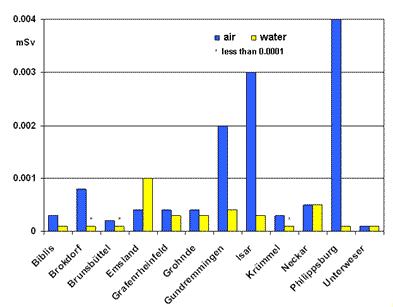The radiationEnergy dispersion through matter or space. In atomic physics... exposure in the environment of nuclear facilities is determined for the reference person defined in the Radiation ProtectionRadiation protection deals with the protection of individual... Ordinance based on the results of emissionThe discharge (e.g. solid, liquid or gaseous substances, sou... control in accordance with the process stipulated in the “General administrative regulation for the determination of radiationEnergy dispersion through matter or space. In atomic physics... exposure by disposal of radioactive substancesRadioactive substances within the meaning of the Atomic Ener... from nuclear plants or facilities”. The calculation of radiationEnergy dispersion through matter or space. In atomic physics... exposure of the population in 2010 in the vicinity of nuclear power plants by the emissionThe discharge (e.g. solid, liquid or gaseous substances, sou... of radioactive substancesRadioactive substances within the meaning of the Atomic Ener... with exhaust air resulted in an effective doseMeasure of a radiation effect to be indicated more precisely... for adults of 0.004 mSv as the highest value for the Nuclear Power PlantThermal power plant, primarily used for electricity generati... Philippsburg; this is 1.5 % of the limit value of the Radiation ProtectionRadiation protection deals with the protection of individual... Ordinance. The highest value of the thyroid gland doseMeasure of a radiation effect to be indicated more precisely... for infants was calculated at 0.007 mSv (less than 1 % of the corresponding dose limit valueDose value of an ionizing radiation fixed by the legislator ...) for the Nuclear Power PlantThermal power plant, primarily used for electricity generati... Philippsburg.
The highest value of the effective doseMeasure of a radiation effect to be indicated more precisely... for adults from emissions of radioactive substancesRadioactive substances within the meaning of the Atomic Ener... with the waste water from nuclear power plants amounted to 0.001 mSv (0.3 % of the dose limit valueDose value of an ionizing radiation fixed by the legislator ...) at the location of the Nuclear Power PlantThermal power plant, primarily used for electricity generati... Emsland.
The radiationEnergy dispersion through matter or space. In atomic physics... exposure at the lower reaches of the rivers has been closer examined with consideration of all emitters. For the mouth of the Neckar, an effective doseMeasure of a radiation effect to be indicated more precisely... of about 0.0008 mSv for adults and of 0.0013 mSv for infants was established; at the lower reaches of Main and Weser 0.0003 mSv for adults and 0.0005 mSv for infants were calculated. On the Rhine and the Danube, the effective doses for adults were around 0.0001 to 0.0004 mSv.

RadiationEnergy dispersion through matter or space. In atomic physics... exposure for adults at the most unfavourable point in the vicinity of nuclear power plants by emissionThe discharge (e.g. solid, liquid or gaseous substances, sou... of radioactive substancesRadioactive substances within the meaning of the Atomic Ener... with the exhaust air (left) and waste water (right), 2010
